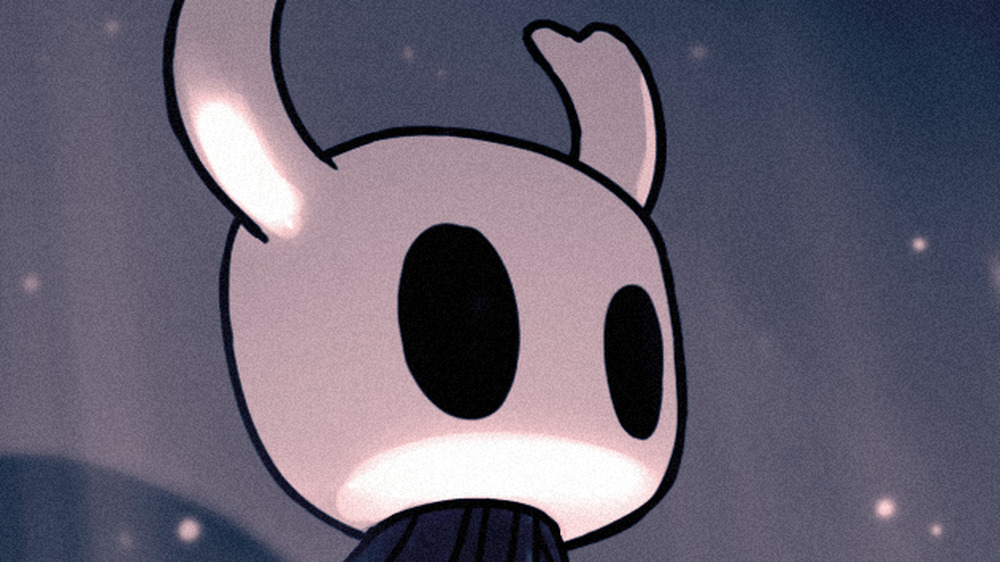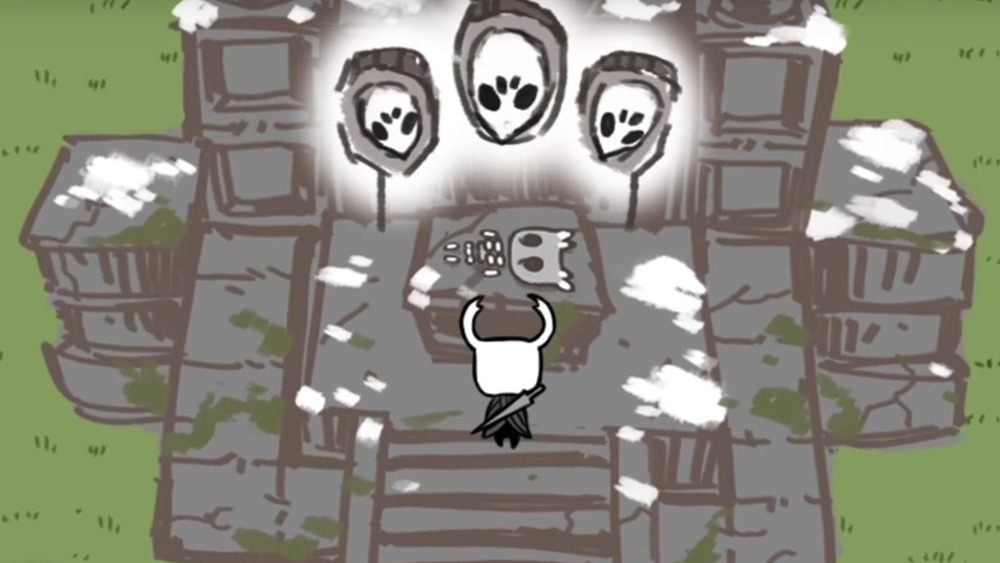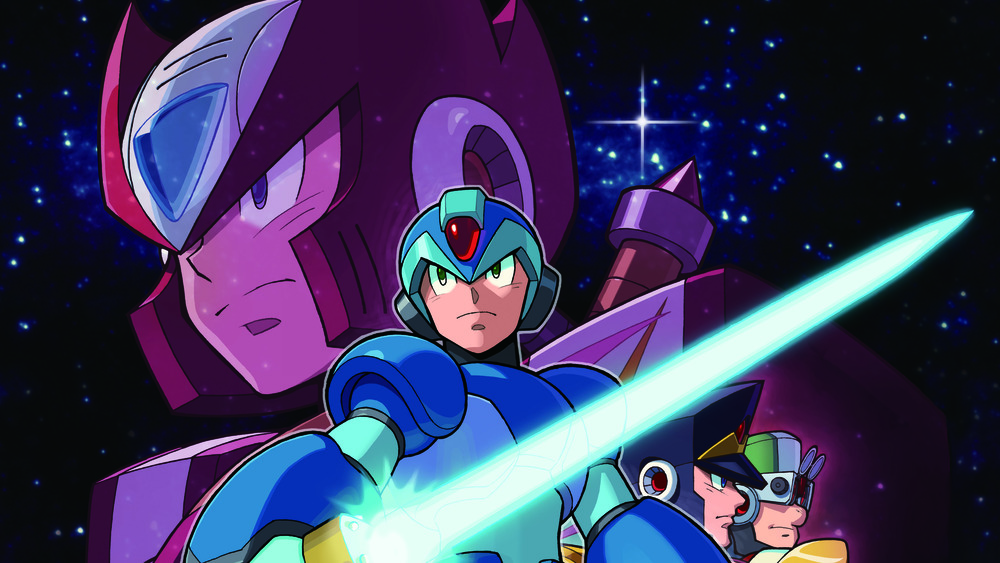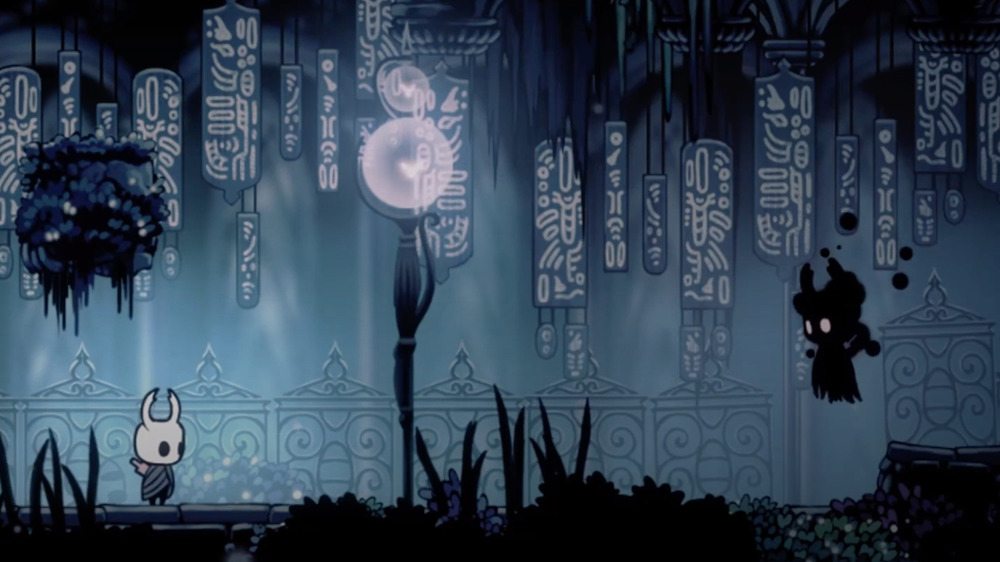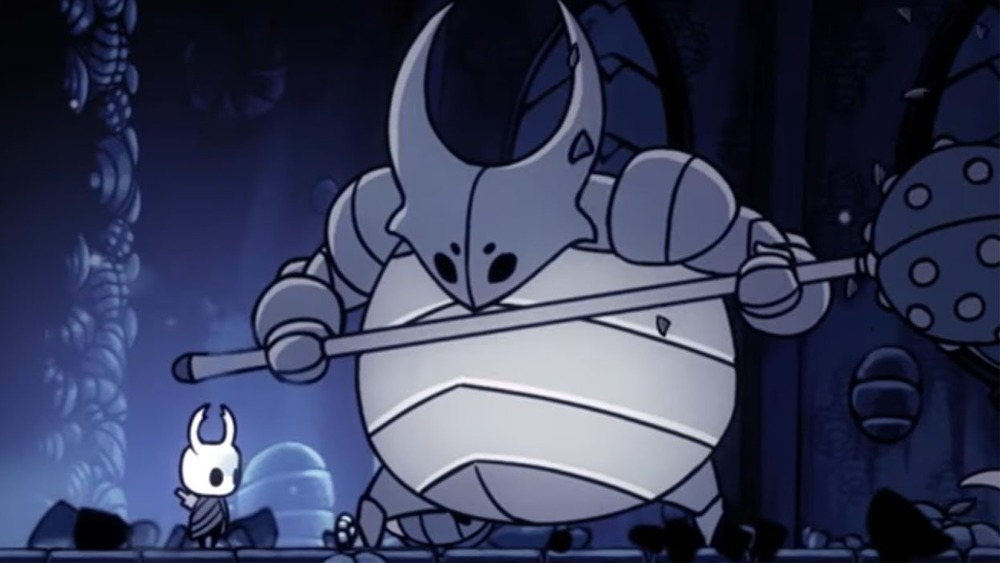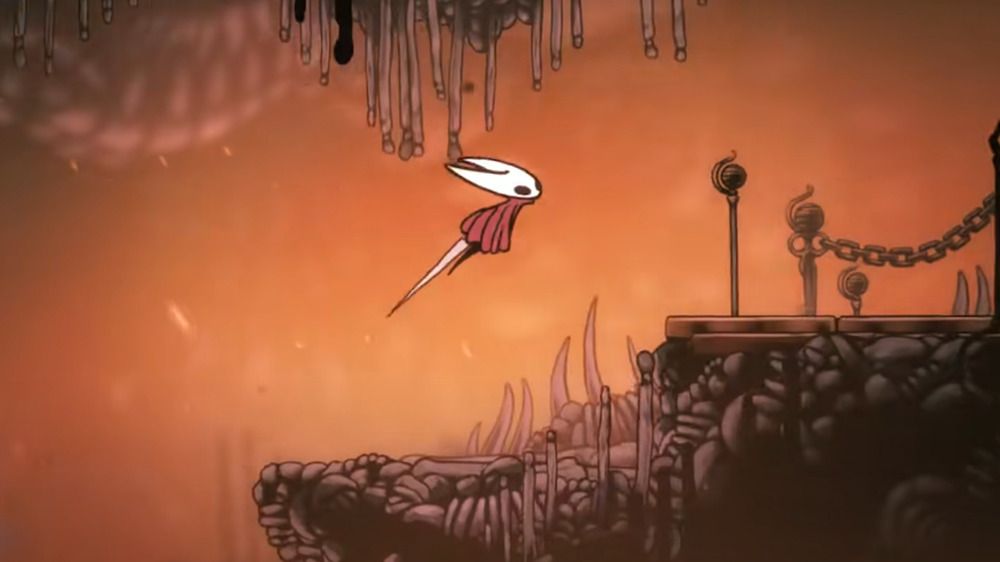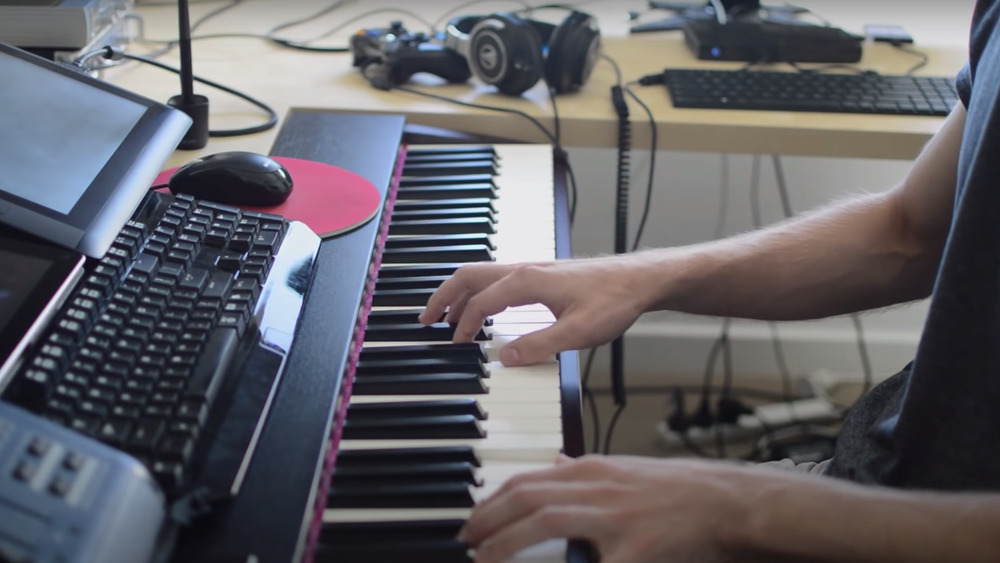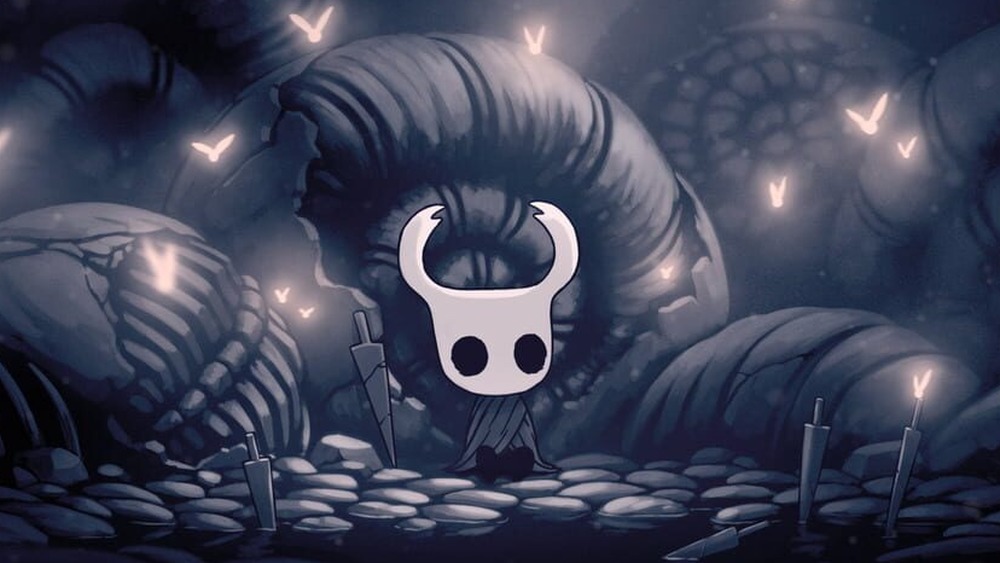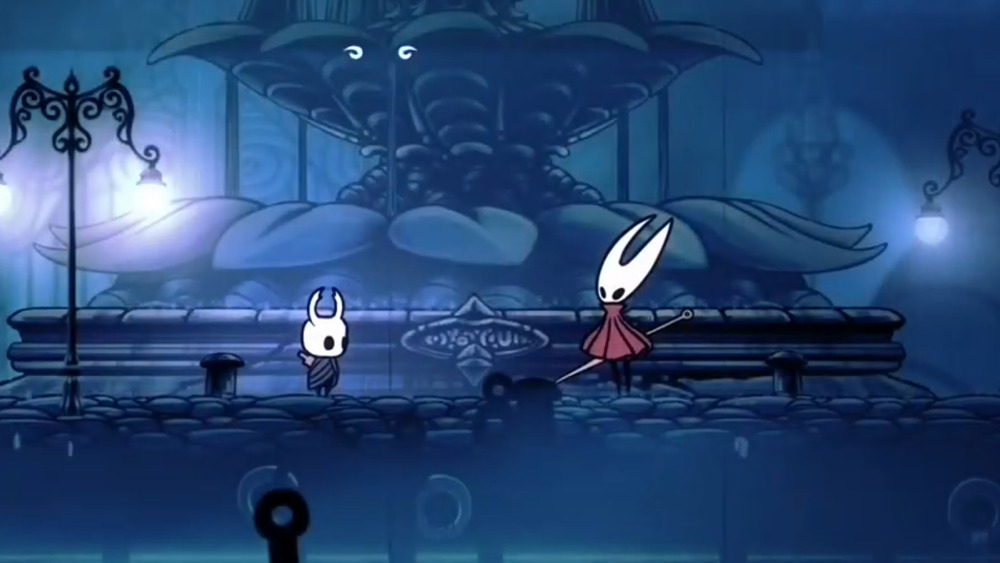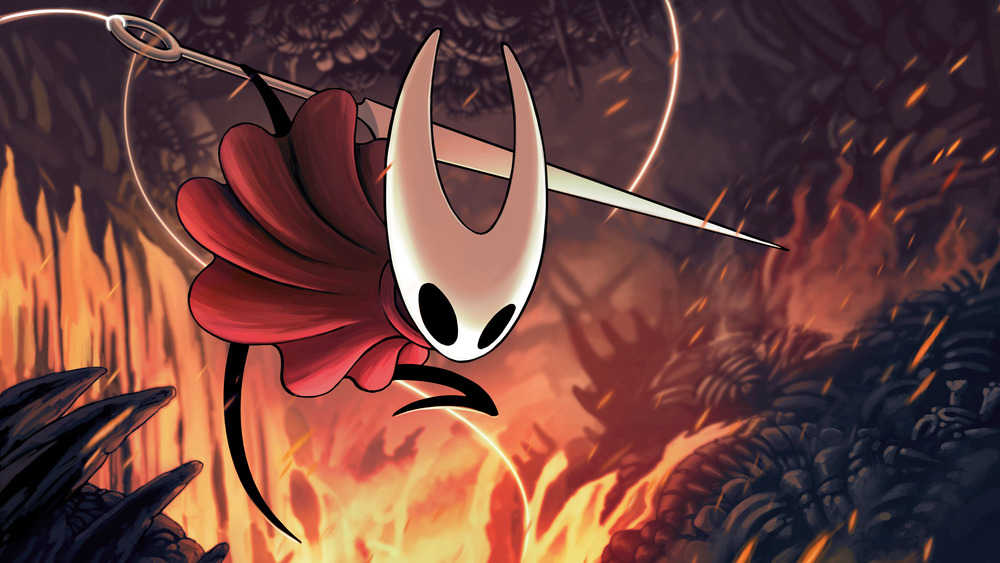The Untold Truth Of Hollow Knight
Hollow Knight has had plenty of twists and turns, even outside of actual gameplay. William Pellen and Ari Gibson, the founders of Team Cherry, took to Kickstarter with about five finished sections of the world's map and a modest funding goal of AU$35,000.
Within the last few days of the Kickstarter, backers boosted the team past this sum, with money to spare on stretch goals. With that funding in hand, it was time for Team Cherry to start its journey through creative obstacles and triumphs. Players know that Hallownest is a maze on its own, but not everybody knows the background behind this beloved 2D platformer.
Team Cherry regularly communicates with its fanbase, though the team may keep the most spoiler-heavy details behind closed doors. Through interviews and blogs, Team Cherry has revealed a good bit insight on the development process behind its indie hit — and slipped fans some fun facts along the way. Here are just a few highlights of Hollow Knight's lore and the story of its creation.
Two failed games combined into one
Hollow Knight combines the concepts behind two games into one glorious adventure. Pellen and Gibson created Hungry Knight, their first game together, at the Ludum Dare indie game jam. However, players weren't exactly impressed. According to Game Informer, Hungry Knight originally received one out of five stars when it was posted to Newgrounds (although, that score has risen after Hollow Knight's release). The game featured a familiar-looking masked protagonist, killing bugs in a fight to survive an insect apocalypse.
Pellen and Gibson brainstormed their second concept at another Ludum Dare. They conceived the idea of an underground kingdom for the "Beneath the Surface" theme of that year's game jam, but they couldn't finish the project. Gibson told Rock Paper Shotgun that the idea was simply too ambitious to complete within the event's 72-hour time limit.
After stewing on the two ideas from these experiences, the indie developers duo decided to build a new game based on both. The game they imagined starred an insect-like knight exploring a kingdom beneath the surface.
These games inspired Hollow Knight
Team Cherry points to a few particular games as inspirations for Hollow Knight: Metroid, Zelda 2, Faxanadu, and Mega Man. Metroid mostly factored into the map design, partially by virtue of the game itself being part of the "Metroidvania" sub-genre. The team wanted an experience where the players could enjoy "getting lost and finding your way."
Zelda 2 and Faxanadu are two of the older games Team Cherry mentioned in an interview with Kotaku. Instead of outright emulating these games, the team instead tried to imitate the "feeling there could be anything hidden around the corner." As intended, Hollow Knight hides secret rooms filled with monsters and lore behind breakable walls and false floors.
Mega Man and Mega Man X especially influenced the Knight's jump mechanics. Team Cherry used the jumping from these games as an example of what they wanted for Hollow Knight: a chargeable vertical jump without any horizontal acceleration.
More specifically, Gibson has described the jump as such: "The Knight has no acceleration or deceleration on horizontal movement. The jump has a lot of initial lift, releasing the button cuts vertical speed quickly." Team Cherry aimed to create a jump with enough aerial control to make players feel like they can dodge last-second hits or mistakes.
Interview spurred devs to create Shades
William Pellen told Game Informer that he originally wasn't sure what to tell fans when they asked about what would happen when the Knight died. This conversation inspired Pellen and Gibson to come up with a way for the Knight to come back from death with a renewed sense of purpose. Team Cherry had already finished a skull-cracking death animation for the Knight, but hadn't considered how to incorporate it into the final product.
Pellen and Gibson kicked a couple of ideas back and forth about what should happen if players returned to the places they last died. One idea had players actually breaking open the dropped skull to retrieve the Geo, or currency, they left behind upon defeat. Another involved fighting an enemy possessing the skull for the lost loot. Eventually, they landed on an idea where players needed to defeat a spirit of their past life for the Geo. This ghostly double later evolved into the Shades seen in the game.
Character design process kept simple
Ari Gibson, who created most of Hollow Knight's settings and characters, usually drew the concept art in his sketchbook and then scanned them straight into the game engine for editing. When Gibson shared his sketchbooks with Rock Paper Shotgun, he said that he created some of the sprites on the fly, or even uploaded them only after a single sketch.
"Sketches like these, while seriously crude, form the basis for most of the game," Gibson told Rock Paper Shotgun. "Almost everything within makes its way into the final game. Very little is wasted." Gibson estimates that this strategy saved a significant amount of production time.
Gibson spearheaded the art direction as the game's artistic supervisor. However, he pointed out that most of the game's aesthetics and art were conceived alongside co-creator William Pellen. Pellen, an artist and animator in his own right, also contributed his own designs. Cornifer the Cartographer is just one example of Pellen's design work.
Boneforest cut to make time for the rest of the map
Boneforest, a massive lava-filled section at the bottom of the Hollow Knight world, didn't make it into the game. Gibson claims that they cut the section because of how much time it would have taken to refine.
"It seemed so cool! But it was totally the right thing to do," Gibson told Game Informer. "William and I were already slammed with all the other enormous areas to build, and they all would have suffered for Boneforest's inclusion." In the end, Team Cherry thought it'd be wiser to invest in polishing the other sections of the map.
The duo revised multiple areas. They reduced the size of Deepnest, which they believe would've been overwhelmingly large if they hadn't done so. Kingdom's Edge, one of the last areas to be added, cannibalized outstanding content and ended up with its own unique identity.
While Boneforest didn't appear in Hollow Knight, Team Cherry ultimately recycled the concept into the map for Hollow Knight: Silksong. Fans noticed a familiar fiery, bone-filled area in early Silksong footage. Mossbag, a popular Hollow Knight content creator, confirmed that Team Cherry said a version of Boneforest will be seen in the sequel.
The soundtrack incorporates leitmotifs
Narrative significantly affects how Christopher Larkin, the game's music producer and sound designer, composes his music. In an interview posted on his YouTube channel, Larkin mentions leitmotifs as narrative devices for echoing themes throughout the game. According to Merriam-Webster, a leitmotif is a "melodic phrase or figure that accompanies the reappearance of an idea, person, or situation." The piano and viola especially personify Hollow Knight's score. Larkin provided the piano recordings himself, while Tim Cheel played the viola and Amelia Jones sang the vocals.
Larkin didn't specify any leitmotifs, but some content creators have. 8-bit Music Theory, a YouTuber who specializes in analyzing video game music, has pointed out a few key notes in the Hollow Knight title theme as a leitmotif. He claims that the leitmotif might represent the Knight and its vessel brethren. In his Hollow Knight video, he shows examples of the leitmotif manifesting in boss fights against characters like the Broken Vessel and the Hollow Knight itself. The leitmotif supposedly also appears in fights against the False Knight and Watcher Knight, who are both literally "hollow" knights, because they're animated suits of armor.
The Knight is genderless
Team Cherry confirmed that the Knight is genderless in a Reddit AMA. Throughout the game, other characters refer to the Knight as "it." In the lore of Hollow Knight, all vessels, including the Knight, spawned from the souls of the Pale King and White Lady. Vessels don't have reproductive organs like insects. They are essentially Void husks that were only created as a means for fighting the mysterious Infection. Players generally point to this as the reason why vessels are genderless.
Hornet, the daughter of the Pale King, differs from her siblings as the "gendered child." She's the only one specifically referred to as "she." However, her origins also differ from her siblings: her mother is Herrah the Beast, not the White Lady. She's not a vessel like the Knight, which might be why she has a gender. In one of his YouTube videos, Mossbag also argues that Hornet isn't made from Void like the rest of the Pale King's children.
The Knight's gender doesn't factor into gameplay. However, some fans appreciate the representation that the skull-faced protagonist offers.
Hornet was originally supposed to star in DLC
Hornet, one of Hollow Knight's most popular characters, starts as a recurring antagonist that defends her kingdom against intruders like the Knight. Later, as the player progresses through the game, she participates in building the lore and even helps the Knight in some instances. She was supposed to be a playable character in a DLC expansion. Instead, she became the main character of the sequel, Hollow Knight: Silksong.
Team Cherry announced the plan to turn the DLC into a sequel in a blog post on the official TC website. The expansion apparently developed beyond the size of a mere DLC, so Team Cherry decided to just make it into a separate game. Although the wait would be longer, Team Cherry promised that it'd be worth it. Backers who paid for the DLC would get Silksong for free, as if it were the DLC they were originally promised.
Hornet significantly shaped Silksong's gameplay
Team Cherry adjusted its designs to accommodate for the differences between Hornet and the Knight. Hornet's DLC was supposed to include new areas and gameplay unique to her character. Her weapons and abilities, such as her spear and silk thread, also change what the game allows the player to do.
For one, Hornet is faster and more agile than the Knight, and will move around Silksong's world differently. She's also taller. "Hornet can travel so much faster, she can jump higher, she can mantle or clamber onto ledges, she's generally more acrobatic," Gibson told EDGE Magazine. "So the caves around her need to accommodate her height." These were only a few of the differences that the devs needed to account for when designing Hollow Knight: Silksong.
Silksong features Hornet and her own personal adventure through an unknown "haunted kingdom." Although Silksong's combat differs from the original game's, it still retains the same sense of wonder and exploration.

